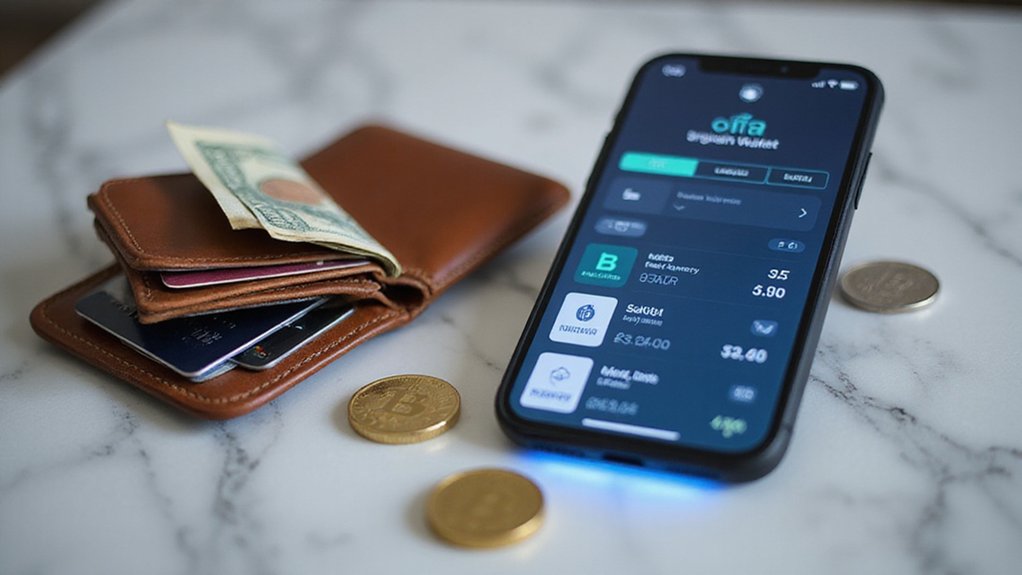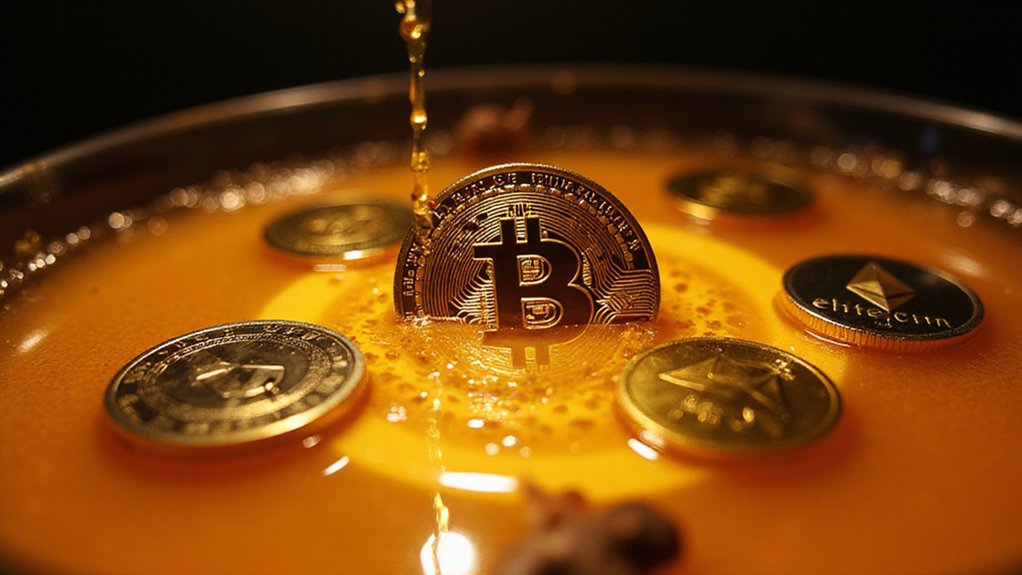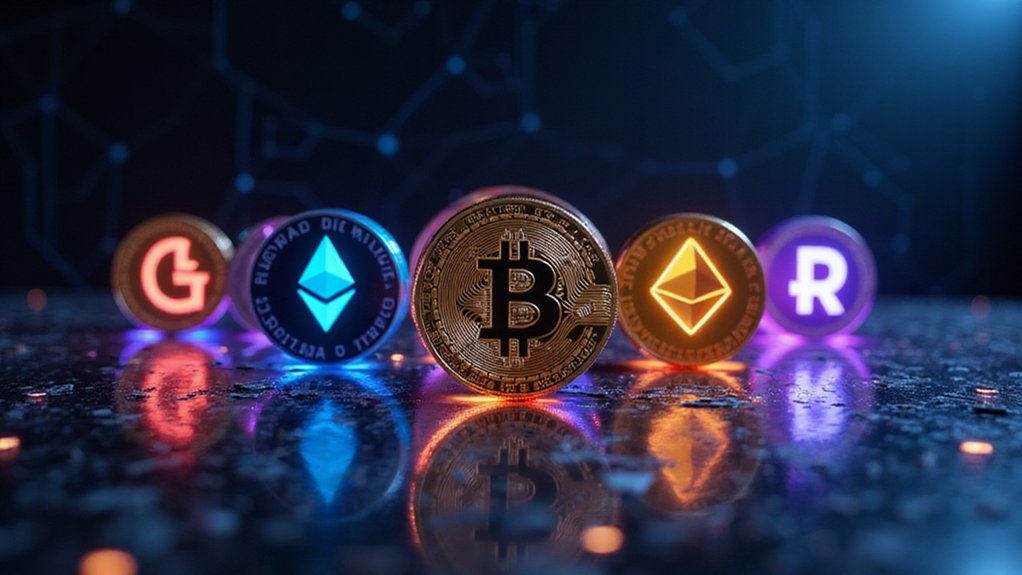A fiat wallet is a digital financial tool that stores government-issued currencies (dollars, euros, etc.) within centralized systems, bridging traditional banking and cryptocurrency ecosystems. Unlike crypto wallets with their private-key labyrinth, fiat wallets employ conventional username-password combinations and two-factor authentication while offering familiar banking safeguards. These wallets manifest across platforms like PayPal, Coinbase, and Revolut, enabling seamless deposits via various payment methods. The fiat wallet’s elegance lies in its unassuming role as gatekeeper to the crypto frontier.

A fiat wallet—that often-overlooked workhorse of modern digital finance—serves as the critical bridge between traditional banking systems and the increasingly complex world of digital transactions.
Essentially, this digital tool enables users to store, transfer, and manage government-issued currencies—dollars, euros, pounds, et al.—with functionality akin to a conventional bank account, albeit one optimized for the peculiarities of online use.
While many enthusiasts fixate on cryptocurrency’s disruptive potential, these fiat repositories quietly facilitate the mundane yet necessary activities that still dominate our financial lives.
The fiat wallet’s significance becomes particularly apparent within the cryptocurrency ecosystem, where it functions as the liminal space between conventional finance and blockchain-based assets.
At the threshold of two financial worlds, fiat wallets broker the uneasy marriage between old-world banking and cryptocurrency’s experimental frontier.
When investors wish to capitalize on market fluctuations (which, remarkably, continue to occur with startling regularity), these wallets provide the immediate liquidity required to convert government-backed currencies into their volatile digital counterparts—and back again when prudence inevitably reasserts itself.
Unlike their crypto counterparts, fiat wallets don’t require private keys or seed phrases; they instead rely on the familiar infrastructure of username-password combinations and two-factor authentication.
These wallets manifest across various platforms—mobile applications like PayPal and Revolut, web-based interfaces embedded within exchanges such as Binance and Coinbase, and increasingly as features within traditional banking apps themselves¹.
The security mechanisms protecting these repositories typically combine traditional banking safeguards with digital protections, often including insurance coverage against platform failures (though rarely against user error, as many discover too late).
This infrastructure operates under regulatory frameworks that vary wildly by jurisdiction but generally provide more oversight than their crypto equivalents.
Many users appreciate that these platforms support bank account integration for seamless deposits and transfers, eliminating the complexity often associated with cryptocurrency transactions.
The distinction between fiat and crypto wallets remains fundamental—the former handles government-issued currencies within centralized systems, while the latter manages blockchain-based assets through decentralized networks.
Users can typically deposit funds into their fiat wallets via multiple payment methods, including debit cards, credit cards, or direct bank transfers for quick access to the cryptocurrency markets.
For platforms like Coinbase, fiat wallets enable users to trade among over 240 assets without repeatedly connecting to external banking systems for each transaction.
Together, they form the complementary components of an increasingly integrated financial ecosystem that continues to blur the boundaries between traditional and digital finance.
¹A trend that represents the banking industry’s grudging acknowledgment of changing consumer expectations.
Frequently Asked Questions
How Secure Are Fiat Wallets Compared to Cryptocurrency Wallets?
Fiat wallets offer established regulatory protections and insured safety nets—luxuries cryptocurrency enthusiasts might view as quaint relics of centralized finance.
Crypto wallets, while boasting sophisticated cryptographic security, transfer the burden of protection entirely to users (lose your private keys, kiss your assets goodbye).
The security question ultimately hinges on one’s preference: traditional financial guardrails with recourse options, or self-sovereign control with its accompanying responsibility.
Neither is impervious to human error or malicious actors.
What Fees Are Typically Associated With Fiat Wallet Transactions?
Fiat wallet transactions typically incur a constellation of fees that can rapidly erode one’s capital: credit/debit deposits (approximately 3%), withdrawal charges (particularly for wire transfers at $25+), foreign transaction fees (~2%), and conversion costs when switching between currencies.
While ACH transfers often remain mercifully free, users should remain vigilant about minimum thresholds, inactivity penalties ($4.95/month after dormancy), and the occasionally bewildering array of provider-specific charges that vary dramatically by region and platform.
Can I Access My Fiat Wallet Internationally?
Most fiat wallets are accessible internationally, though usage abroad comes with important caveats.
While the digital nature permits global connectivity, regulatory compliance varies dramatically by jurisdiction—what works seamlessly in Singapore might trigger compliance alarms in Switzerland.
Users should verify country-specific restrictions, anticipate potential KYC reverification requirements, and prepare for the possibility of heightened transaction fees when crossing borders.
The wallet provider’s geographical footprint ultimately determines real-world accessibility rather than theoretical reach.
Are Fiat Wallets Insured Against Theft or Fraud?
Many fiat wallets offer insurance protection against theft and fraud, particularly those integrated with established banking systems.
Coverage policies vary considerably between providers—some offering thorough protection while others (rather predictably) bury limitations in fine print.
Bank-connected wallets typically include standard FDIC insurance up to $250,000, while third-party services may provide private insurance with different terms.
Users should scrutinize these policies before entrusting their funds to any digital repository, lest they discover the limitations at precisely the wrong moment.
How Quickly Can I Transfer Money Between Fiat Wallets?
Transfer speeds between fiat wallets vary dramatically based on infrastructure and connectivity.
Internal transfers within the same platform occur nearly instantaneously—a rare efficiency in financial services—while cross-platform movements remain tethered to traditional banking timelines.
Interac transfers (Canada’s contribution to monetary velocity) complete within minutes, whereas SEPA transfers trudge along at 2-3 business days.
Card-based transfers offer immediacy at premium fees, embodying that tiresome financial truism: convenience always commands a premium.









